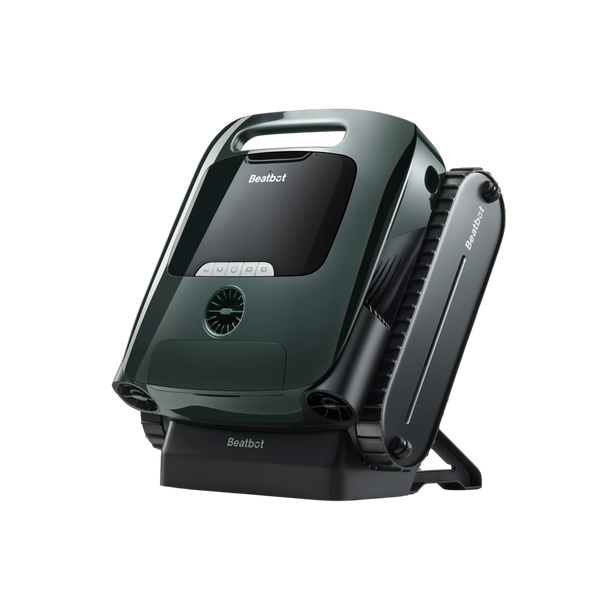The Fastest Way to Get Rid of Yellow Algae in Your Pool
Yellow algae, also known as mustard algae, can turn your pool into a slimy, unsightly mess. But fear not, pool owners! With the right approach, you can wave goodbye to this pesky problem and get back to enjoying crystal clear water.
Table of content

What is Mustard Algae?
Mustard algae is a type of algae that's a close cousin to green algae, but it's more stubborn. It can be yellowish, yellow-green, or even brown, and it's often slimy. It loves to cling to pool surfaces, light fixtures, and anything else it can get its slimy grip on. It's resistant to chlorine, which makes it a tough nut to crack.
What Causes Yellow Algae in Swimming Pools?
Yellow algae, often a stubborn nuisance in swimming pools, arises from several contributing factors. Understanding these can help you maintain a crystal-clear pool and prevent algae blooms.
Inadequate Filtration and Chlorination
At the root of yellow algae issues are two primary culprits: insufficient filtration and inadequate chlorine levels. When your pool's filtration system is not running effectively, particles and microorganisms can accumulate, creating a conducive environment for algae growth. Additionally, if chlorine levels dip too low, the water loses its ability to sanitize effectively, allowing algae to thrive.
Operational Factors
Several aspects of pool operation can further exacerbate these issues:
Pump Speed and Run Time: The speed and duration at which your pool pump operates are crucial. For instance, in hot climates like Central Florida, longer pump run times are necessary to ensure effective water circulation and filtration. A minimum of 8 hours is often recommended during peak summer months.
Filter Maintenance: A clean and functional filter is essential. Clogs or damage can compromise your system's ability to keep water clean, directly increasing the risk of algae development.
Sanitation Method and Bather Load: Pools with heavy usage may require more rigorous sanitation processes to handle increased contaminants from swimmers.
Environmental and Structural Factors
Leaks: Pools with undetected leaks struggle to maintain stable chlorine levels. Leaks can lead to lowered stabilizer levels, which help chlorine remain effective, especially in sunny conditions. This is particularly important in regions with high sun exposure.
Seasonal Changes: As temperatures rise, especially during seasonal transitions, pools become more susceptible to yellow algae. For example, sudden increases in temperature and humidity in early spring create an optimal environment for algae growth. During such times, monitoring and adjusting chlorine levels become critical.
By addressing these factors proactively, you can significantly reduce the likelihood of yellow algae appearing. Regular maintenance, vigilant observation, and timely adjustments are key to a summer of worry-free swimming.
Why You Need to Act Fast: The Urgency of Tackling Mustard Algae
When it comes to mustard algae, procrastination is not an option. Here's why swift action is crucial in dealing with this pesky pool invader:
Resistance to Chlorine: Mustard algae is notorious for its resistance to standard chlorine levels found in pools. This means that if you wait to address the issue, the algae can continue to thrive and spread, making it even more difficult to eradicate later on.
Contamination of Pool Accessories: Mustard algae spores can latch onto pool toys, floats, and even swimsuits. If these items aren't sanitized promptly, they can act as carriers, reintroducing spores back into the pool and perpetuating the problem.
Health Risks: While mustard algae is not directly harmful to humans, the bacteria and other microorganisms that can thrive alongside it can pose health risks. Prompt action is necessary to minimize the risk of illness.
Prevention of Future Outbreaks: By addressing mustard algae promptly, you can implement preventive measures that make future outbreaks less likely. This includes maintaining proper water chemistry and sanitation practices that keep algae at bay.
How Do Leaks Aid in Yellow Algae Growth in Swimming Pools?
Leaks pose a significant threat to swimming pools, especially when it comes to yellow algae infestations. Here's how they contribute to this problem:
Chlorine Levels Disruption : Leaks make it challenging to maintain consistent chlorine levels, which are essential for preventing algae growth. When water escapes from the pool, it takes chlorine with it, diminishing its effectiveness.
Imbalance in Stabilizer Levels : Stabilizers play a crucial role in protecting chlorine from degrading quickly under the sun’s UV rays. Leaks disturb the stabilizer balance, reducing the longevity and efficiency of chlorine, thus paving the way for algae to thrive.
Impact on Saltwater Pools : For saltwater pools, leaks result in the loss of salt necessary for chlorine production. Without adequate salt levels, the system can't generate enough chlorine, creating an ideal environment for yellow algae to flourish.
In essence, maintaining structural integrity and promptly addressing leaks are vital to keeping your pool algae-free.
Step-by-Step Guide to Banish Mustard Algae:
Before diving into the process, ensure you have all the necessary equipment and chemicals on hand. Here's what you'll need:
- Chemical test kit : Crucial for testing and balancing your pool’s water chemistry.
- Chlorine : For shocking the pool and soaking accessories.
- Hose & jet sprayer : To clean pool surfaces effectively.
- Diatomaceous Earth (DE) : If you have a DE filter, this will be essential.
- Pole, brush, net, and vacuum : For brushing surfaces and removing debris.
1. Decontaminate Pool Accessories:
- Remove all items from the pool that can harbor algae spores, like toys and floats.
- Wash swimwear in hot water with color-safe bleach to kill any lurking spores.
- Soak pool tools and other accessories in a chlorine solution to ensure they're algae-free.
2. Brush and Vacuum Surfaces:
- Turn off the pump and give your pool a good brushing to loosen up the algae.
- Vacuum up the debris that's fallen to the bottom of the pool.
- Don't forget to backwash or clean your filter to remove any trapped algae.
3. Test and Balance Your Water Chemistry:
- Make sure your pH is between 7.2 and 7.4, and your alkalinity is between 60 and 120 ppm.
- Balance your cyanuric acid levels between 20 and 40 ppm to ensure your sanitation is effective.
4. Superchlorinate Your Pool or Spa:
- Shock your pool with extra chlorine to break down the resistant compounds that mustard algae loves.
- Add your shock at dusk or night and keep your filter running 24/7 until the algae are gone.
5. Balance and Clean Water for a Few Days:
- After shocking, keep testing and balancing your water.
- Brush the pool as normal for a few days to ensure any remaining spores are removed.
6. Prevent Future Outbreaks:
- Keep your water chemistry balanced and your filtration system running for at least 12 hours a day.
- Regularly vacuum and brush your pool surfaces to prevent spores from settling.
- Use an algaecide to proactively protect your pool water.
By following these meticulous steps and ensuring you have the right tools and chemicals, you can effectively tackle mustard algae and keep your pool pristine.
How Pump Speed, Run Time, and Weather Affect Yellow Algae Growth in Pools
Keeping yellow algae at bay requires understanding several critical factors including pump speed, run time, and weather conditions. Each plays a significant role in maintaining your pool's clarity and health.
Pump Speed and Run Time
Pump Speed : The speed at which your pool's pump operates dictates how efficiently water circulates and gets filtered. Slower pump speeds might save energy, but they can also reduce the effectiveness of algae prevention. Optimizing your pump speed ensures that water is moving consistently, which limits algae's ability to settle and thrive.
Run Time : This refers to how long your pump is active each day. Longer run times are crucial, especially during peak seasons or in regions with warmer climates. For instance, if your pool is exposed to high temperatures, you might need to extend pump operation beyond the average time. Instead of the typical 6-hour cycle, consider running your pump for at least 8 hours to prevent algae proliferation.
The Impact of Weather
Weather Conditions : Hot, humid conditions create an ideal breeding ground for yellow algae. The combination of warmth and moisture accelerates algae growth, making it essential to adjust your pool maintenance routine during these times. In regions with intense heat, such as the southern states during the summer months, vigilance is key. Ensuring your pool stays adequately sanitized and filtering frequently can make a significant difference.
By understanding these elements and adapting your maintenance practices accordingly, you can effectively manage and prevent yellow algae, keeping your pool inviting and clear. Regular adjustments based on these factors, along with consistent checks of chemical levels and sanitation methods, will provide a reliable defense against algae growth.
Is It Necessary to Drain a Pool to Get Rid of Algae?
In most cases, draining your pool to eliminate algae is not necessary. The majority of algae issues can be resolved with proper chemical treatment and maintenance. Here’s how you can tackle the problem without draining:
1. Shock Treatment
Use a chlorine shock treatment to kill the algae. This involves adding a high dose of chlorine to the water, which disrupts algae growth and eventually eliminates it.
2. Algaecide Use
Apply a suitable algaecide. These products are specifically designed to target algae, making them an effective addition post-shock treatment to prevent future growth.
3. Brush and Vacuum
Physically remove the algae by brushing all pool surfaces, including walls and floors. Follow up with a thorough vacuum to remove loosened algae particles.
4. Filter Maintenance
Ensure your pool filter is cleaned and operating efficiently. A good filter helps keep your water clear and free from algae-promoting debris.
5. Regular Maintenance
Maintain proper water balance by frequently checking pH and chlorine levels. Consistent maintenance can prevent algae from making a comeback.
In rare cases where algae problems persist despite these measures, and if your pool has an unusually high buildup of Total Dissolved Solids (TDS), draining might be considered. However, such situations are uncommon, and most pools can be restored without the need to empty them entirely.
Advanced Solution: BeatBot AquaSense Pro
For a high-tech approach, consider the BeatBot AquaSense Pro. This system monitors your pool's water quality and automatically adjusts chemical levels to target and eliminate mustard algae. It's a smart investment for pool owners who want to keep their pools algae-free with minimal effort.

Conclusion
Mustard algae is a nuisance, but with a bit of elbow grease and the right approach, you can keep your pool clean and clear. Remember, prevention is key, so keep those chemicals balanced, and those filters clean. And if you're looking for a cutting-edge solution, the BeatBot AquaSense Pro might just be the pool accessory you never knew you needed. Now, go ahead and dive into a mustard-free pool experience!
Relative Blogs
About the author



















